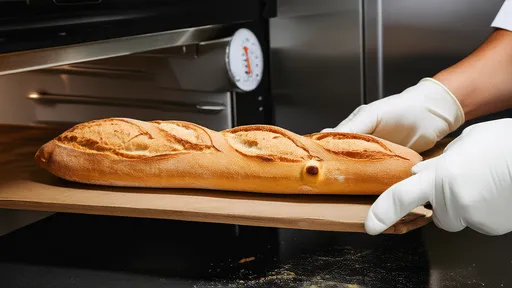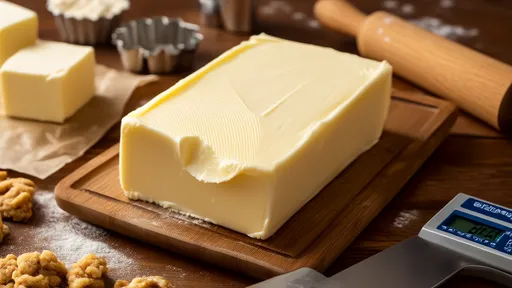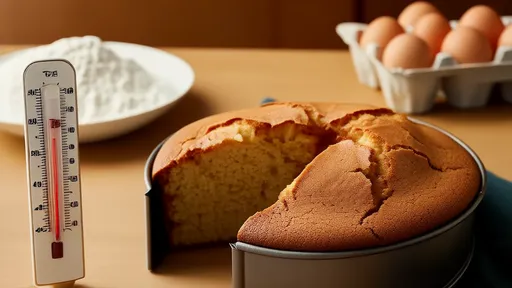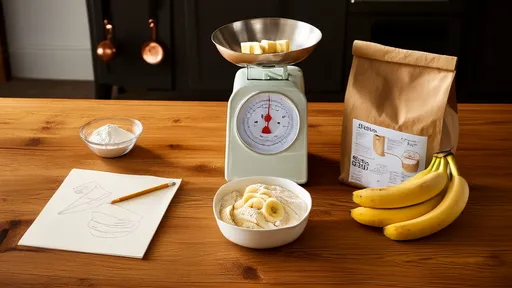For home bakers pursuing the perfect chiffon cake, few sights are more disheartening than pulling a cracked masterpiece from the oven. While conventional wisdom blames incorrect ingredient ratios or mixing techniques, emerging evidence suggests your oven's hidden temperature spikes may be the true culprit behind those unsightly fissures.
The Deceptive Nature of Oven Thermometers
Most bakers rely on built-in oven thermometers or standalone models placed inside the chamber, unaware these devices often fail to capture micro-temperature fluctuations. During rigorous testing, professional kitchens discovered standard thermometers can lag by 15-30 seconds when recording rapid temperature changes - enough time for crucial damage to occur during a chiffon's delicate rise.
Industrial thermal imaging reveals what home bakers cannot see: while your oven display shows a steady 325°F, the actual cavity temperature may be spiking to 375°F in certain zones before the thermostat corrects it. These micro-spikes create uneven heating patterns that force the cake's structure to expand too rapidly, causing surface cracks as the interior continues rising at a different pace.
Why Chiffon Cakes Betray Us
The unique composition of chiffon cakes makes them particularly vulnerable to temperature deception. Their signature airy texture comes from whipped egg whites folded into the batter, creating millions of microscopic air pockets. When subjected to sudden heat increases, these pockets expand violently while the surrounding liquid batter hasn't fully set, resulting in structural fractures we see as cracking.
Commercial bakeries combat this phenomenon using convection ovens with sophisticated air circulation systems that maintain temperature consistency within ±5°F. Most home ovens, even high-end models, typically fluctuate between ±25-50°F despite digital displays suggesting perfect stability. This variance falls within manufacturer tolerances but wreaks havoc on delicate baked goods.
The Silent Crack Timeline
Thermocouple data logging tells a revealing story: during the first 12 minutes of baking - the critical period when chiffon structure sets - many home ovens exhibit 3-5 undocumented temperature surges. These spikes often correlate with the oven's cycling pattern as elements turn on/off to maintain average temperature. Each surge stresses the developing cake matrix, with cracks appearing minutes later as visible symptoms of earlier trauma.
Interestingly, cracks don't always form immediately during overheating. The damage frequently occurs during subsequent cooling when the over-expanded surface contracts faster than the interior. This explains why some bakers observe perfect cakes straight from the oven that develop cracks during cooling - the injury happened earlier but only became visible during temperature equalization.
Forensic Baking: Identifying Temperature Crimes
Seasoned bakers develop subtle ways to diagnose hidden overheating. The "crust color test" proves particularly telling - if your chiffon develops darker edges or surface coloring before the center has fully risen, your oven likely has hot spots or temperature spikes. Another indicator is erratic rising; cakes that dome dramatically then collapse often suffered from inconsistent heating rather than recipe errors.
Advanced home bakers now employ data loggers that record temperature fluctuations throughout the baking process. These devices frequently uncover troubling patterns: one test oven registered 18 separate temperature excursions during a single bake cycle, with spikes occurring precisely when the thermostat engaged the heating element. The worst offenders? Older electric ovens and gas ranges with poorly calibrated thermostats.
Counterintuitive Solutions
Paradoxically, the solution might involve baking at slightly higher average temperatures. By setting your oven 25°F higher than recommended and placing a baking steel or stone on the lower rack, you create a thermal buffer that minimizes fluctuations. The mass absorbs excess heat during spikes and radiates it back during dips, effectively smoothing out the temperature curve.
Water baths, long used for cheesecakes, show promise for chiffon cakes as well. Placing the cake pan in a shallow tray of water helps regulate bottom heat and slows the overall temperature transfer, giving the delicate structure more time to adapt to changes. Some bakers report success with this method despite initial skepticism about introducing steam to an airy cake.
The humble oven thermometer requires reevaluation. Instead of a single unit, professionals recommend placing three thermometers in different oven zones and tracking their variance throughout the bake cycle. This "temperature mapping" reveals whether your oven has consistent hot spots that need accommodation in your baking strategy.
Manufacturers' Dirty Little Secret
Appliance engineers privately acknowledge that consumer oven temperature stability has worsened in recent decades as manufacturers prioritize rapid preheating over thermal consistency. The shift from analog to digital controls created an illusion of precision while actual cavity temperatures became more erratic. One technician admitted, "We design ovens to reach advertised temperatures quickly, not to hold them steadily."
This revelation explains why vintage ovens from the 1970s-80s often produce superior baked goods despite lacking modern features. Their heavier construction and simpler thermostats provided inherent temperature stability that today's lightweight, energy-efficient models sacrifice. For serious bakers, investing in a used commercial oven or high-end residential model with dual thermostats may prove worthwhile.
The chiffon crack mystery underscores a broader truth in baking: what we see as failures often stem from invisible equipment limitations rather than technique errors. By understanding our ovens' hidden behaviors, we can adapt our methods to work with - rather than against - their imperfections, turning cracked disappointments into consistently sublime creations.

By /Jul 24, 2025

By /Jul 24, 2025

By /Jul 24, 2025

By /Jul 24, 2025

By /Jul 24, 2025

By /Jul 24, 2025

By /Jul 24, 2025

By /Jul 24, 2025

By /Jul 24, 2025

By /Jul 24, 2025

By /Jul 24, 2025

By /Jul 24, 2025

By /Jul 24, 2025

By /Jul 24, 2025

By /Jul 24, 2025

By /Jul 24, 2025

By /Jul 24, 2025

By /Jul 24, 2025